 |
|
|
|

|
|||
| |
|||
Powdery mildew was detected on celery last week in the Yuma Valley by an observant PCA. Small and inconspicuous colonies of the fungal pathogen were present on leaves and stalks. Powdery mildew on celery was first reported in North America (California) in 1994. The pathogen, Erysiphe heraclei, has also been reported on celery in several European countries and in South America (Chile). Erysiphe heraclei is also known to occur on carrot and parsley in the United States. Research in California has shown that the celery pathogen can cause powdery mildew on parsley as well. As with powdery mildew on other crops, the initial infection sites are small and often not easily seen. However, under favorable disease development conditions the fungus will continue to grow and produce massive numbers of spores, which will in turn initiate more infections to rapidly escalate disease development. The most favorable temperature range for spore germination is about 65 to 77 °F. Also, moderate levels of relative humidity are required for infection, growth and sporulation by the pathogen. Finally, low light intensity favors powdery mildew development. These conditions can all be found within a maturing crop of celery this time of year.
To contact Mike Matheron go to: matheron@ag.arizona.edu.
|
|||
| Back | |||
For questions or comments on any of the topics please contact Marco Pena at the Yuma Agricultural Center. |
|||
| Home | Cotton
| Veggies | Forages
| Grains | Citrus
| Crop x Crop Insects | Diseases| Weeds | Pesticides | Economics | News | Weather | Research | Photos | Contacts | General Info. Copyright © 2001 University of Arizona, College of Agriculture and Life Sciences Webmaster: Al Fournier (acis@ag.arizona.edu) |
|||
